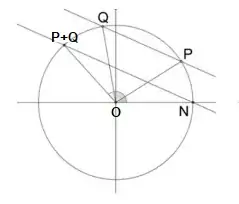Preliminary: One reason that in the (algebro-geometric) theory of $\mathbb{Q}$ arbitrary powers $p^q$ are not considered is, that there is no finite Euclidean construction which would yield $p^q$ for arbitrary lengths $p$ and $q$. This already and most prominently holds for $q = \frac{1}{3}$: While $\sqrt[2]{p}$ can be constructed, $\sqrt[3]{p}$ can not.
On the unit circle the sum of two angles $\alpha = \angle NOP$ and $\beta = \angle NOQ$ (= two arc lengths $\overline{NP}$, $\overline{NQ}$) can be constructed:
which - by the way - has a strong similarity (by the use of parallels) with the multiplication of straight lengths:
It turns out that the addition of (arc) lengths on the circle corresponds to the multiplication of two Gaussian numbers in the plane $\mathbb{Q}(i)$: $\alpha \oplus \beta := e^{i\alpha} \cdot e^{i\beta} = e^{i(\alpha + \beta)} $.
If it were possible to unroll the circle onto the straight line, we could add two angles (= arc length) as straight line segments and roll the sum back onto the circle (modulo $2\pi$). Even though unrolling is not possible (by Euclidean constructions), addition of angles is possible (taking something like a magic shortcut, see above).
What would the multiplication of arc lengths on the circle correspond to? If unrolling were possible we could multiply angles in the same way that we add them: unroll the arc lengths $\alpha, \beta$ onto the straight line, multiply them here (see above) and roll the product back onto the circle (modulo $2\pi$).
How can it be seen that there is no "magic geometric shortcut" - as in the case of addition - that yields the product of two arbitrary angles modulo $2\pi$?
The only (?) way we can construct multiplication on the unit circle is by restricting the numbers/points/angles/arc lengths to some roots of unity $\omega_m^n = e^{i2\pi n/m}$. We then can multiply two numbers by $\omega_m^p \otimes \omega_m^q := \omega_m^q \oplus \dots \oplus \omega_m^q = \omega_m^{pq}$.

